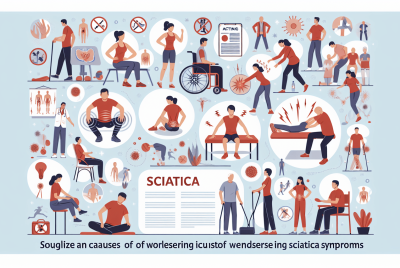Posture Improvement, Back Pain Posture Tips
Are you tired of dealing with constant back pain? Do you find yourself slouching and hunching over throughout the day? Well, look no further! In this article, we will provide you with valuable tips and techniques to improve your posture and alleviate back pain. Say goodbye to discomfort and hello to a healthier, more aligned you. Say goodbye to discomfort and hello to a healthier, more aligned you.
Understanding The Importance of Good Posture
Good posture refers to the correct alignment of your body while standing, sitting, or lying down. It involves keeping your body in a position that puts the least amount of strain on your muscles, bones, and joints. While it may seem like a minor concern, maintaining good posture is crucial for overall health and wellbeing.
What is Good Posture?
Good posture involves aligning your body in a way that promotes optimal balance and support. When you have good posture, the natural curves of your spine are maintained, and the muscles and ligaments supporting your spine are not strained. This allows your body to function at its best and reduces the risk of developing musculoskeletal issues.
Good posture can be characterized by:
- Standing up straight with your head directly over your shoulders, and your shoulders aligned with your hips.
- Keeping your chin parallel to the ground, not tilted up or down.
- Maintaining a straight back while sitting, with your feet flat on the ground.
- Avoiding slouching or hunching over.
The Effects of Poor Posture
On the other hand, poor posture can have detrimental effects on your overall health. It can lead to various musculoskeletal issues such as back pain, neck pain, headaches, and even digestive problems. When you consistently maintain poor posture, the muscles, ligaments, and joints in your body become strained and overworked, leading to discomfort and pain.
Additionally, poor posture can also affect your breathing and cardiovascular function. When your body is not properly aligned, it can restrict the movement of your diaphragm, making it difficult to take deep breaths. This can result in shallow breathing and decreased oxygen intake, which can negatively impact your energy levels and overall sense of wellbeing.
How Posture Affects Back Pain
One of the most common consequences of poor posture is back pain. When you slouch or hunch over, it puts excessive pressure on the muscles and ligaments in your back, leading to pain and discomfort. Over time, this can contribute to the development of chronic back conditions such as herniated discs, sciatica, and spinal misalignments.
Maintaining good posture, on the other hand, helps distribute the weight of your body evenly and reduces the strain on your back muscles. This can alleviate existing back pain and prevent the onset of future issues. By improving your posture, you can significantly reduce the risk of chronic back pain and improve your overall spinal health.
Assessing Your Current Posture
Before you can start improving your posture, it’s essential to assess your current posture and identify any imbalances or areas of improvement. Here are some tips for assessing your posture:
Identifying Postural Imbalances
Stand in front of a mirror and observe your body from the front, back, and sides. Pay attention to any deviations from the ideal posture, such as:
- Uneven shoulder heights or one shoulder higher than the other
- A tilted pelvis or visible curvature in your lower back
- Head tilted forward or excessively backward
- Uneven alignment of the ears, shoulders, and hips
Take note of any imbalances you observe, as these will be areas to target for improvement.
Evaluating Your Sitting Posture
The majority of people spend a significant amount of time sitting, whether it’s at work, in the car, or at home. Therefore, it’s crucial to assess and improve your sitting posture. When sitting, make sure to:
- Sit with your back against the chair, utilizing the chair’s lumbar support if available.
- Keep your feet flat on the ground or supported by a footrest.
- Avoid crossing your legs or sitting with your legs crossed for prolonged periods.
- Position your computer monitor at eye level and ensure the keyboard and mouse are within easy reach.
By evaluating and optimizing your sitting posture, you can reduce strain on your back and neck and improve overall comfort.
Observing Your Standing Posture
Stand naturally and observe your posture from all angles. Pay attention to the following:
- Are your shoulders rounded forward or pulled back?
- Is your pelvis tilted forward or backward?
- Are your knees locked or slightly bent?
- Do you have a noticeable sway in your lower back?
Make adjustments as needed to align your body correctly. This may involve consciously pulling your shoulders back and down, tucking in your pelvis slightly, and engaging your core muscles.
Exercise and Stretching for Posture Improvement
In addition to maintaining proper posture throughout the day, incorporating specific exercises and stretches into your routine can help strengthen the muscles that support good posture and improve flexibility. Here are some exercises and stretches that can be beneficial for posture improvement:
Posture Strengthening Exercises
- Plank: Get into a push-up position, and instead of bending your elbows, place your forearms on the ground. Keep your body in a straight line from head to toe and hold the position for 30 seconds to 1 minute.
- Superman: Lie facedown on a mat with your arms extended overhead and your legs straight. Lift your arms and legs off the ground simultaneously, aiming to create a slight arch in your back. Hold for a few seconds before returning to the starting position. Repeat 10-15 times.
- Bridge: Lie on your back with your knees bent and feet flat on the ground. Slowly lift your hips off the ground, keeping your back straight. Hold the position for a few seconds before lowering back down. Repeat 10-15 times.
These exercises target the core, back, and glute muscles, which play a significant role in supporting proper posture.
Upper Body Stretches
- Neck Stretch: Tilt your head gently to one side, bringing your ear toward your shoulder. Hold for a few seconds before switching sides. Repeat 5-10 times.
- Chest Stretch: Stand with your feet hip-width apart, and clasp your hands behind your back. Straighten your arms and lift them towards the ceiling while squeezing your shoulder blades together. Hold for 20-30 seconds.
- Shoulder Rolls: Stand or sit upright and roll your shoulders forward, then backward in a circular motion. Repeat 10-15 times.
These stretches target the neck, chest, and shoulder muscles, which can become tight and tense from poor posture.
Lower Body Stretches
- Hamstring Stretch: Sit on the edge of a chair with one leg extended in front of you. Lean forward slightly, keeping your back straight, and reach for your toes. Hold for 20-30 seconds before switching legs. Repeat 3-5 times on each leg.
- Hip Flexor Stretch: Step forward with your right foot into a lunge position. Keep your torso upright and gently push your hips forward until you feel a stretch in the front of your left hip. Hold for 20-30 seconds before switching sides. Repeat 3-5 times on each leg.
- Calf Stretch: Stand facing a wall, place one foot slightly behind the other, and lean forward, resting your hands against the wall for support. Keep your back leg straight and press your heel into the ground, feeling a stretch in your calf muscle. Hold for 20-30 seconds before switching sides. Repeat 3-5 times on each leg.
These stretches target the hamstrings, hip flexors, and calf muscles, which can become tight and contribute to poor posture.
Ergonomics and Posture at the Workplace
Considering the amount of time spent at work, it’s crucial to prioritize ergonomics to promote good posture. By making a few adjustments to your workspace, you can significantly reduce the strain on your body and minimize the risk of developing musculoskeletal problems. Here are some tips for setting up an ergonomic workstation:
Choosing the Right Chair
Investing in a chair that provides proper lumbar support and promotes good posture is essential. Look for a chair that allows you to adjust the height, backrest, and armrests to suit your body and workstation setup. Ensure that your feet are flat on the ground or supported by a footrest, and your knees are bent at a 90-degree angle when seated.
Setting Up an Ergonomic Workstation
- Monitor Placement: Position your computer monitor at eye level, approximately an arm’s length away from you. This helps prevent straining your neck or leaning forward excessively.
- Keyboard and Mouse: Keep your keyboard and mouse at a comfortable distance from your body to avoid reaching or straining. Ensure that your wrists are in a neutral, relaxed position while typing or using the mouse.
- Desk Setup: Adjust the height of your desk so that your forearms are parallel to the ground when typing, and your shoulders are relaxed. Use a keyboard tray or a desk with an adjustable height to achieve the correct positioning.
Taking Frequent Breaks
Sitting for prolonged periods can lead to poor circulation, muscle stiffness, and discomfort. Incorporate regular breaks into your workday to stretch, walk around, and change your posture. Set a timer to remind yourself to Take a 5-minute break every hour to get up, move, and give your body a break from prolonged sitting. This will help alleviate strain on your muscles and promote better posture.
Making Posture Corrections a Habit
Improving your posture requires more than just occasional exercise and stretches. It’s essential to make posture corrections a habit and be mindful of your body alignment throughout the day. Here are some tips for incorporating good posture into your daily routine:
Improving Posture While Sleeping
Ensure that your mattress and pillow provide adequate support for your body while sleeping. Avoid sleeping on your stomach, as this can strain your neck and spine. Instead, try sleeping on your back or side with a supportive pillow to maintain proper spinal alignment.
Practicing Mindful Posture Throughout the Day
Make a conscious effort to check your posture regularly throughout the day. Whenever you catch yourself slouching or hunching over, correct your posture by pulling your shoulders back and down, lengthening your spine, and engaging your core. Over time, these small adjustments will become second nature, and you’ll naturally maintain good posture.
Using Postural Aids
Postural aids, such as lumbar rolls or posture braces, can provide additional support and remind your body to stay in the correct alignment. These aids can be particularly helpful when sitting for long periods or during activities that require you to maintain a specific posture.
The Role of Footwear in Posture Improvement
Believe it or not, your choice of footwear plays a significant role in your overall posture. Wearing the wrong shoes can throw off your body’s alignment, leading to poor posture and increased risk of musculoskeletal issues. Here are some tips for choosing footwear that supports good posture:
Selecting Supportive Shoes
Choose shoes that offer good arch support and cushioning. Look for shoes with a firm sole, as this helps distribute your body weight evenly and reduces strain on your feet and joints. Opt for shoes with a wide toe box to allow your toes to splay and maintain proper foot alignment.
Avoiding High Heels and Flip Flops
High heels alter the natural alignment of your body, placing excessive pressure on the balls of your feet, toes, and lower back. If you need to wear heels, opt for lower heights and look for styles that offer more stability and cushioning.
Flip flops, on the other hand, lack the support and stability needed for proper posture. These shoes provide minimal arch support and can lead to foot and ankle instability. If you enjoy wearing flip flops, consider opting for ones with arch support and a contoured footbed.
The Importance of Insoles
If you have specific foot conditions or pronation issues, using orthotic insoles can provide additional support and help correct your posture. Insoles can help distribute pressure more evenly across your feet and reduce strain on your lower limbs and back. Consult with a podiatrist or footwear specialist to determine the right type of insoles for your specific needs.
Nutrition and Hydration for Healthy Posture
Maintaining a healthy diet and staying properly hydrated can also contribute to good posture. Here are some tips on how nutrition and hydration can support your posture:
Maintaining a Healthy Weight
Excess weight can put strain on your muscles and joints, leading to poor posture and increased risk of discomfort and pain. By maintaining a healthy weight through a balanced diet and regular exercise, you can reduce the load on your body and promote better posture.
Eating Foods for Good Bone Health
Eating a diet rich in calcium, vitamin D, and other essential nutrients can promote strong bones and help prevent conditions such as osteoporosis. Strong bones provide a solid foundation for good posture and reduce the risk of fractures and spinal deformities.
Staying Hydrated
Proper hydration is crucial for maintaining healthy muscles and joints. Dehydration can lead to muscle cramps and stiffness, which can negatively impact your posture. Aim to drink at least 8 cups of water per day and adjust your intake based on your activity level and climate.
Posture and Mental Wellbeing
The benefits of good posture extend beyond physical health and can also have a positive impact on your mental wellbeing. Here’s how posture can contribute to overall mental wellness:
The Mind-Body Connection
The mind and body are interconnected, and research has shown that changes in body posture can affect mood, self-esteem, and overall mental state. Maintaining an upright posture helps open up your body and project confidence, which can boost your mood and promote positive emotions.
Reducing Stress and Tension
Poor posture can lead to increased muscular tension and stress on your body. By actively improving your posture and reducing muscular strain, you can alleviate physical discomfort and promote a sense of relaxation. Additionally, sitting or standing with proper posture can help release tension in your muscles and reduce stress levels.
Posture and Confidence
Maintaining good posture can help boost your confidence and self-image. Standing tall and proud not only improves your physical appearance but also sends a positive message to others. Good posture exudes confidence and can enhance your overall presence and interactions with others.
Seeking Professional Help for Posture Improvement
In some cases, improving posture may require the assistance of healthcare professionals. Here are some options to consider if you’re struggling to correct your posture:
Physical Therapy and Chiropractic Care
Physical therapists and chiropractors can provide personalized treatment plans and exercises to address postural imbalances and alleviate pain. They can evaluate your posture, identify any underlying issues, and provide targeted interventions to improve your overall alignment and muscle strength.
Posture Correcting Devices
There are various posture correcting devices available on the market that can assist in improving posture. These devices range from posture-correcting shirts and braces to wearable technology that provides real-time feedback on your posture. Consult with a healthcare professional to determine the right type of device for your specific needs.
Surgical Options
In severe cases of postural issues, when all other interventions have been exhausted, surgical options may be considered. However, surgery is typically reserved for extreme cases and should be discussed thoroughly with a medical professional.
Tips for Maintaining Good Posture on the Go
Maintaining good posture doesn’t only apply to stationary activities. Whether you’re driving, traveling, or exercising, it’s important to prioritize posture to reduce the risk of discomfort and pain. Here are some tips for maintaining good posture on the go:
Improving Posture While Driving
- Adjust your seat so that your knees are at a 90-degree angle and your feet comfortably reach the pedals.
- Sit straight with your back supported by the seat, and avoid slouching or leaning to one side.
- Use a lumbar roll or cushion for additional support and to maintain the natural curve of your lower back.
Maintaining Posture While Traveling
- When sitting for long periods on a plane or train, bring a lumbar roll or cushion to support your lower back.
- Take regular breaks to stand up, walk around, and stretch your muscles. Use restroom breaks as an opportunity to move and stretch.
- Be mindful of your posture while carrying heavy luggage. Distribute the weight evenly and avoid hunching over.
Proper Posture during Exercise
Maintaining proper posture during exercise is important to prevent injury and optimize the effectiveness of your workouts. Here are some guidelines to follow:
- Engage your core muscles to stabilize your spine and maintain good posture throughout your exercises.
- Avoid overarched or rounded posture during strength training exercises. Keep your back straight and avoid excessive twisting or bending.
- Use proper form and technique during cardio exercises such as running or cycling to ensure proper alignment and reduce strain on your joints.
By paying attention to your posture during various activities, you can prevent unnecessary strain on your body and promote overall well-being.
In summary, understanding and maintaining good posture is crucial for overall health and wellbeing. By making a conscious effort to improve your posture, addressing any imbalances, incorporating exercises and stretches, optimizing your workstation, and prioritizing ergonomics, you can significantly reduce the risk of musculoskeletal problems and improve your physical and mental wellbeing. Remember to seek professional help for persistent postural issues, and prioritize good posture even when on the go. With dedication and consistency, you can achieve and maintain a healthier and more aligned posture.




